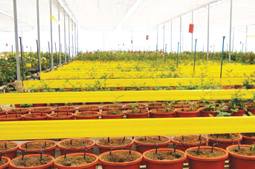Wilting Under New Rules, Competition
With a perfect allyear growing climate, affordable labor and access to temperature-controlled air freight, Kenya has all the ingredients to become one of the top flower producers in the world.
 Hopes by Kenya’s flower growers to exploit the lucrative United States market and stop dependence on the European market has not borne much fruit despite the recent launch of direct flights between Nairobi and New York.
Hopes by Kenya’s flower growers to exploit the lucrative United States market and stop dependence on the European market has not borne much fruit despite the recent launch of direct flights between Nairobi and New York.
In spite of optimism and excitement after national carrier Kenya Airways (KQ) started direct flights to the US, the airline’s business strategy of focusing on passengers as opposed to cargo has dashed the hopes of the flower industry of targeting the market that has remained elusive.
This is bad news for the industry which despite being the second leading foreign exchange earner after tea, is grappling with a myriad of challenges that are threatening the country’s position as Africa’s leading producer of cut flowers.

 For more than 200 years, the heart of the global trade in cut flowers has been the Netherlands. The world’s largest global auction for flowers began, famously, in a pub. One trader turned to his peers and asked, how much?
For more than 200 years, the heart of the global trade in cut flowers has been the Netherlands. The world’s largest global auction for flowers began, famously, in a pub. One trader turned to his peers and asked, how much? Ask any coach and He will tell you that when his fate depends on competitors’ match, the situation is out of control. So, it is with Kenya’s flower sector as our fate in the flower sector is determined by others. The truth is, we are in a catch 22 situation. This is the time for Kenya to think outside the Box and redeem its flower and export sector.
Ask any coach and He will tell you that when his fate depends on competitors’ match, the situation is out of control. So, it is with Kenya’s flower sector as our fate in the flower sector is determined by others. The truth is, we are in a catch 22 situation. This is the time for Kenya to think outside the Box and redeem its flower and export sector. Kibiru is a Dedicated, self-motivated, enthusiastic and strategic thinking professional with 10 years’ experience in the Agriculture sector as an Agronomist. Well versed in all phases of horticultural crop production, specifically in floriculture and Olericulture, People management, production and sustainable use of conventional crop protection agents in harmony with the Bio- control agents. Experienced in managing projects from requirements gathering/ needs identification phase all through to completion.
Kibiru is a Dedicated, self-motivated, enthusiastic and strategic thinking professional with 10 years’ experience in the Agriculture sector as an Agronomist. Well versed in all phases of horticultural crop production, specifically in floriculture and Olericulture, People management, production and sustainable use of conventional crop protection agents in harmony with the Bio- control agents. Experienced in managing projects from requirements gathering/ needs identification phase all through to completion. The Global Biopesticides Market was valued at USD 3147.1 million in 2018 and is expected to register a CAGR of 14.1% during the forecast period (2019-2024). Of all the regions, South America is expected to witness the fastest growth in the forecast period, recording a CAGR of 16.4%. In addition, the United States is likely to be the largest individual market over the forecast period.
The Global Biopesticides Market was valued at USD 3147.1 million in 2018 and is expected to register a CAGR of 14.1% during the forecast period (2019-2024). Of all the regions, South America is expected to witness the fastest growth in the forecast period, recording a CAGR of 16.4%. In addition, the United States is likely to be the largest individual market over the forecast period. The Agriculture Industry, which is the backbone of our economy, is facing multiple threats from the growth of fake pesticides. According to a latest study conducted, the fake pesticides industry in India was estimated at billions of US dollars globaly, which account for 25 per cent by value and 30 per cent by volume of the domestic pesticides industry . The Study indicates that this market is expected to grow at the rate of 20 per cent per annum in terms of value, and if not addressed, can reach to approximately 40 per cent share by value in the pesticides industry by 2019. The problem is extreme in many countries including Kenya.
The Agriculture Industry, which is the backbone of our economy, is facing multiple threats from the growth of fake pesticides. According to a latest study conducted, the fake pesticides industry in India was estimated at billions of US dollars globaly, which account for 25 per cent by value and 30 per cent by volume of the domestic pesticides industry . The Study indicates that this market is expected to grow at the rate of 20 per cent per annum in terms of value, and if not addressed, can reach to approximately 40 per cent share by value in the pesticides industry by 2019. The problem is extreme in many countries including Kenya.
 The Export Promotion Council (EPC) held the 1st inaugural Kenya Exporter of the Year Awards (KEYA) on 15th July 2019 at KICC aimed to recognize firms that have made significant contribution to the development of the economy through exemplary business performance.
The Export Promotion Council (EPC) held the 1st inaugural Kenya Exporter of the Year Awards (KEYA) on 15th July 2019 at KICC aimed to recognize firms that have made significant contribution to the development of the economy through exemplary business performance.